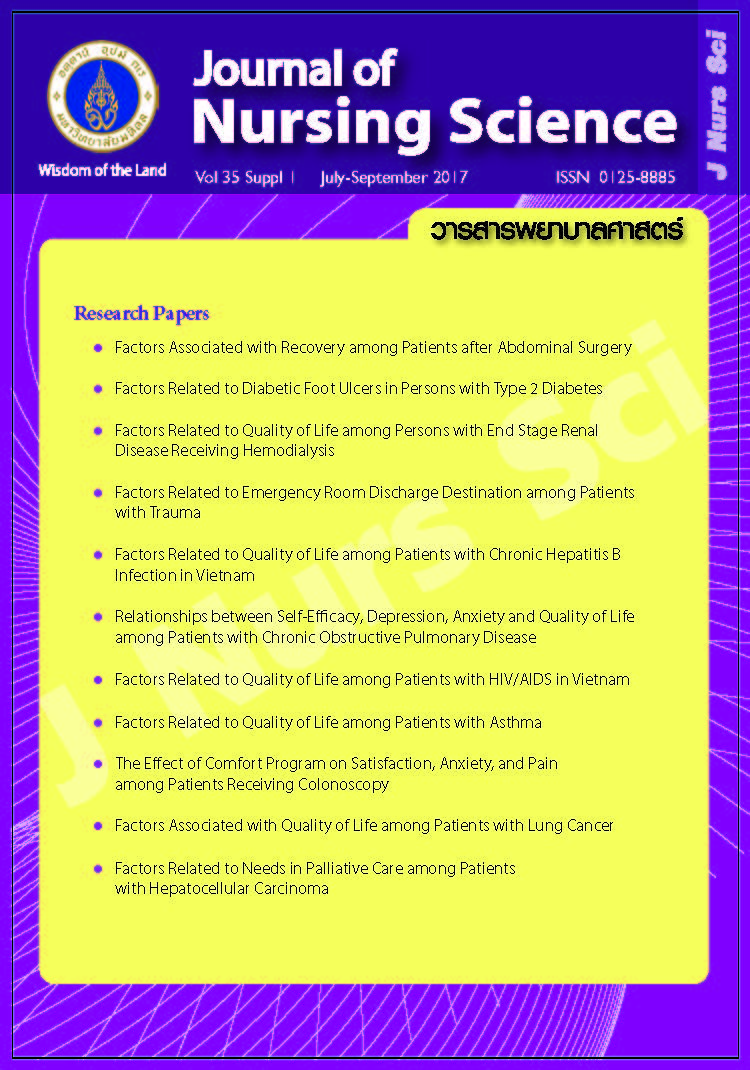Factors Related to Quality of Life among Patients with Chronic Hepatitis B Infection in Vietnam ปัจจัยที่มีความสัมพันธ์กับคุณภาพชีวิตในผู้ป่วยโรคตับอักเสบบีเรื้อรังในประเทศเวียดนาม
Main Article Content
Abstract
Purpose: To investigate the relationships between anxiety, depression, fatigue, social support, and quality of life (QOL) among patients with chronic hepatitis B infection in Vietnam.
Design: Descriptive correlational study.
Methods: Sample was chronic hepatitis B infection patients who were treated at the Department of Infectious Diseases in Bach Mai Hospital, Ha Noi, Vietnam. Data were collected through interview using 5 questionnaires: The Hamilton Anxiety Rating scale (HAM-A), the Hamilton Depression Rating Scale (HAM-D), the Functional Assessment of Chronic Illness Therapy Fatigue Scale (Version 4) (FACIT-F), the Multidimensional Scale of Perceived Social Support (MSPSS), and the SF-36® Health Survey (SF36) to measure QOL. Spearman’s rho was employed to test the relationships between the studied variables and quality of life.
Main findings: The findings supported that anxiety, depression, and fatigue were negatively correlated to quality of life (QOL) among patients with chronic hepatitis B infection (rs = - .550, - .683, and - .541, p < .05, respectively). However, social support was not correlated to quality of life (QOL) significantly among patients with chronic hepatitis B infection (p > .05).
Conclusion and recommendations: From the findings of this study it is suggested that nurses should screen for anxiety, depression, fatigue, and social support of patients with chronic hepatitis B infection in order to provide appropriate care to enhance QOL.
บทคัดย่อ
วัตถุประสงค์: เพื่อศึกษาความสัมพันธ์ระหว่างความวิตกกังวล ภาวะซึมเศร้า ความเมื่อยล้า การสนับสนุนทางสังคมและคุณภาพชีวิต ในผู้ป่วยโรคตับอักเสบบีเรื้อรัง
รูปแบบการวิจัย: การศึกษาเชิงสหสัมพันธ์
วิธีดำเนินการวิจัย: กลุ่มตัวอย่าง คือ ผู้ป่วยโรคตับอักเสบบีเรื้อรังจำนวน 115 รายที่เข้ารับการรักษาที่คลินิกโรคติดเชื้อ ในโรงพยาบาลบาคมาย เมืองฮานอย ประเทศเวียดนาม เก็บรวบรวมข้อมูลโดยการสัมภาษณ์ด้วยแบบสอบถาม ความวิตกกังวล (Hamilton Anxiety Rating Scale: HAM-A) ภาวะซึมเศร้า (Hamilton Rating Depression Rating Scale: HAM-D) แบบวัดความเมื่อยล้า (Fatigue Scale Version 4) การรับรู้การสนับสนุนทางสังคม (MSPSS) และคุณภาพชีวิต (SF36) วิเคราะห์ข้อมูลทั่วไป โดยใช้สถิติเชิงบรรยายและวิเคราะห์ความสัมพันธ์ โดยใช้สถิติ Spearman’s rho
ผลการศึกษา: ความวิตกกังวล ภาวะซึมเศร้า และความเมื่อยล้ามีความสัมพันธ์ทางลบกับคุณภาพชีวิตของผู้ป่วยโรคตับอักเสบบีเรื้อรัง (rs = - .550, - .683, and - .541, p < .05, ตามลำดับ) การสนับสนุนทางสังคมมีความสัมพันธ์กับคุณภาพชีวิตอย่างไม่มีนัยสำคัญทางสถิติ (p > .05).
สรุปและข้อเสนอแนะ: พยาบาลควรคัดกรองความวิตกกังวลและภาวะซึมเศร้าของผู้ป่วยโรคตับอักเสบบีเรื้อรัง และให้การช่วยเหลือที่เหมาะสม รวมทั้งการจัดการอาการเมื่อยล้า และส่งเสริมการสนับสนุนทางสังคม เพื่อส่งเสริมคุณภาพชีวิตของผู้ป่วยโรคตับอักเสบบีเรื้อรัง
Article Details
Copyright Notice: Nursing Science Journal of Thailand has exclusive rights to publish and distribute the manuscript and all contents therein. Without the journal’s permission, the dissemination of the manuscript in another journal or online, and the reproduction of the manuscript for non-educational purpose are prohibited.

Disclaimer: The opinion expressed and figures provided in this journal, NSJT, are the sole responsibility of the authors. The editorial board bears no responsibility in this regard.
References
2. Cornberg M, Jaroszewicz J, Manns MP, Wedemeyer H. Treatment of chronic hepatitis B. Minerva Gastroenterol Dietol. 2010;56(4):451-65.
3. Lavanchy D. Hepatitis B virus epidemiology, disease burden, treatment, and current and emerging prevention and control measures. J Viral Hepat. 2004;11(2):97-107.
4. Ott JJ, Stevens GA, Groeger J, Wiersma ST. Global epidemiology of hepatitis B virus infection: new estimates of age-specific HBsAg seroprevalence and endemicity. Vaccine. 2012;30(12):2212-9.
5. Tu HAT, Woerdenbag HJ, Riewpaiboon A, Kane S, Le DM, Postma MJ, et al. Cost of illness of chronic hepatitis B infection infection in Vietnam. Value Health Reginal Issues. 2012;1(1):23-8.
6. Glise H, Wiklund I. Health-related quality of life and gastrointestinal disease. J Gastroen Hepatol. 2002;17 Suppl :S72-S84.
7. Arvand J, Shafiabadi A, Falsafinejad MR, Naderi N. Depression in patients with chronic hepatitis B: an experience on individual solution-focused therapy. Gastroenterol Hepatol Bed Bench. 2012;5(3):166-8.
8. Modabbernia A, Ashraf M, Malekzadeh R, Poustchi H. A review of psychosocial issues in patients with chronic hepatitis B. Arch Iran Med. 2013;16(2):114-22.
9. Chen Q, Jin GX, He ZB. Analysis of the depressive state of patients with chronic hepatitis and nursing care. Hulixue Zazhi. 2001;16:466 8. (in Chinese).
10. Chan H, Yu CS, Li SY. Psychiatric morbidity in Chinese patients with chronic hepatitis B infection in a local infectious disease clinic. East Asian Arch Psychiatry. 2012;22(4):160-8.
11. Mirabdolhagh Hazaveh M, Dormohammadi Toosi T, Nasiri Toosi M, Tavakoli A, Shahbazi F. Prevalence and severity of depression in chronic viral hepatitis in Iran. Gastroenterol Rep (Oxf). 2015;3(3):234-7.
12. Karacaer Z, Cakir B, Erdem H, Ugurlu K, Durmus G, Ince NK, et al. Quality of life and related factors among chronic hepatitis B-infected patients: a multi-center study, Turkey. Health Qual Life Outcomes. 2016;14:153. doi: 10.1186/s12955-016-0557-9.
13. Karaivazoglou K, Iconomou G, Triantos C, Hyphantis T, Thomopoulos K, Lagadinou M, et al. Fatigue and depressive symptoms associated with chronic viral hepatitis patients. Health-Related Quality of Life (HRQOL). Ann Hepatol. 2010;9(4):419-27.
14. Enescu A, Mitrut P, Balasoiu M, Turculeanu A, Enescu AS. Psychosocial issues in patients with chronic hepatitis B infection and C. Curr Health Sci J. 2014;40(2):93-6.
15. Poorkaveh A, Modabbernia A, Ashrafi M, Taslimi S, Karami M, Dalir M, et al. Validity, reliability and factor structure of hepatitis B quality of life questionnaire version 1.0: findings in a large sample of 320 patients. Arch Iran Med. 2012;15(5):290-7.
16. Kim JH, Kwon SY, Lee YS, Lee JH, Lee YS, Lee CH. Virologic response to therapy increases health-related quality of life for patients with chronic hepatitis B infection. Clin Gastroenterol Hepatol. 2012;10(3):291-6.
17. Faul F, Erdfelder E, Buchner A, Lang AG. Statistical power analyses using G*Power 3.1: tests for correlation and regression analyses. Behav Res Methods. 2009;41(4):1149-60.
18. Webster K, Cella D, Yost K. The Functional Assessment of Chronic Illness Therapy (FACIT) measurement system: properties, applications, and interpretation. Health Qual Life Outcomes. 2003;1:79. doi: 10.1186/1477-7525-1-79.
19. Canty-Mitchell J, Zimet GD. Psychometric properties of the multidimensional scale of perceived social support in urban adolescents. Am J Community Psychol. 2000;28(3):391-400.
20. Ware JE Jr, Sherbourne CD. The MOS 36-item short-form health survey (SF-36): I. conceptual framework and item selection. Med Care. 1992;30(6):473-83.


